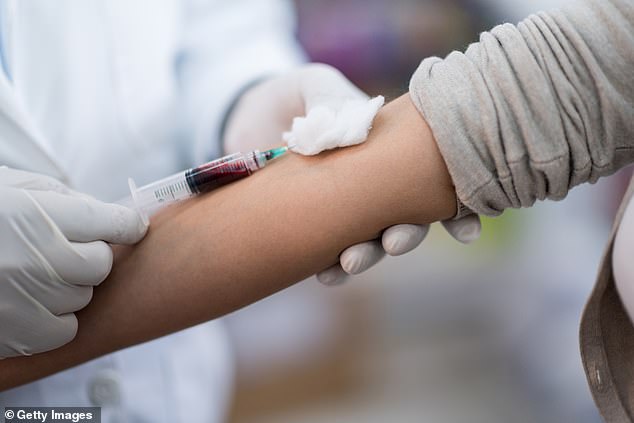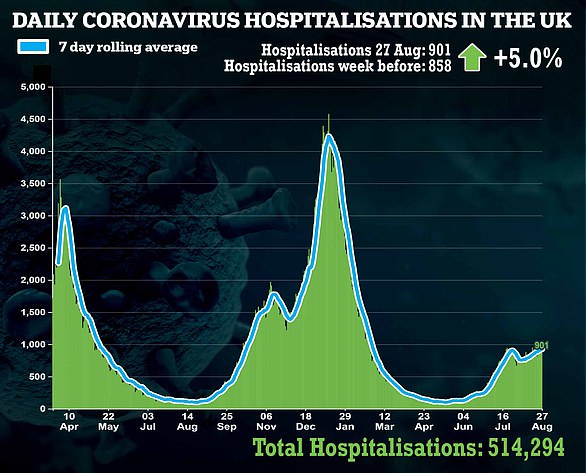A new Covid test said to be better than a lateral flow could become the new first line of defence against the virus in hospitals — and it doesn’t require a painful swab.
Oxford University experts claim they have developed an AI-based test that can spot the virus and give a result in as little as 10 minutes without a throat or nose sample.
All that is required from a patient is a routine blood test, which is already collected for virtually everyone admitted to hospital.
A major study of the test – known as CURIAL-Rapide – on 72,000 NHS patients found it correctly ruled out the infection 99.7 per cent of the time.
The researchers said this was a fifth more accurate than lateral flow devices, which are currently the most commonly used rapid test.
When carried out at the bedside of patients, the new test could give a diagnosis in just 10 minutes — compared to the half an hour it takes on average for a lateral flow.
In emergency departments CURIAL-Rapide produced results in 45 minutes by the time a sample was taken and processed.
This was quicker than the hour it took for lateral flows, which if negative need to be cross-referenced with a PCR.
Many large hospitals have lab facilities where they can process PCR tests — the gold standard of Covid testing — on site.
But CURIAL-Rapide could make a ‘particularly big difference’ in small hospitals which don’t have that luxury and need to send away for results, the Oxford experts said.

A new Covid test said to be better than a lateral flow could become the new first line of defence against the virus in hospitals. It uses artificial intelligence and all that is needed is a routine blood test (stock image)

When carried out at the bedside of patients, the new test could give a diagnosis in just 10 minutes — compared to the half an hour it takes on average for a lateral flow. In emergency departments CURIAL-Rapide produced results in 45 minutes by the time a sample was taken and processed. This was quicker than the hour it took for lateral flows, which if negative need to be cross-referenced with a PCR
Lead researcher Dr Andrew Soltan, a clinician and machine learning researcher at Oxford, said: ‘Many of our patients coming to the ED are in the most vulnerable groups.
‘CURIAL-Rapide is exciting because it uses new near-patient testing to collect all the data needed for a prediction by the bedside in 10 minutes, cutting out the time for transporting samples to a lab.
‘This means infected patients are identified sooner, while patients being admitted with other conditions can be quickly and safely transferred to wards where they are less likely to be exposed.
‘This technology can help hospitals run more smoothly and may make a particularly big difference for smaller hospitals where there isn’t a lab on-site.
‘CURIAL is an example of how the collaborative strength of the NHS, bringing together universities with hospital groups across the country, is helping to build an evidence base for safe and responsible use of clinical AI.’
The AI test uses routine blood tests and vital signs like heart rate and blood pressure to look for signs of viral infection.
The Oxford team are in the process of applying for funding from the Department of Health for a national rollout.
The device was trialled at five hospitals in Oxford, Birmingham, Portsmouth and Bedfordshire between December and March.
Dr Alex Novak, lead consultant for emergency medicine research at Oxford University Hospitals NHS Foundation Trust, said the results were ‘exciting’.
He added it had ‘the power to rapidly translate into tangible benefits for patient care and optimise service performance at the frontline’.
Professor David Clifton, study co-author, said: ‘The University has demonstrated that it has risen to the challenge posed to society by the Covid pandemic, and this AI-driven tool being implemented for use in Emergency Departments is a great example of how we and the NHS can work together to produce something of lasting value to patients.
‘With the emphasis moving to living with Covid every year, research collaborations delivering tools such as CURIAL are the future for our field.
‘Our recently-announced Pandemic Sciences Centre will be a key means of supporting such collaborations in future, with the goal of getting us to a state of advanced preparedness for the arrival of new diseases or variants.’
Britain’s daily Covid hospital admissions breach 1,000 for first time since February
More than 1,000 Covid patients were admitted to hospital in a single day in the UK last week for the first time since February, official data shows as the country’s daily cases grew again and deaths fell.
In its usual daily update, the Department of Health and Social Care revealed that 1,019 people were hospitalised with the virus across the UK on August 25.
It marks the first time there have been four-figure Covid admissions since February 24 when the second wave was being brought under control and the jab rollout was just gaining momentum.

The DOH update — which often includes backlogged hospital data due to the way it’s recorded — showed there were a further 943 Covid admissions on August 26 and 901 on August 27, which were both week-on-week rises.
Meanwhile, there was a mixed picture as UK-wide infections increased by 4 per cent in a week to 32,181 but England’s case numbers fell again, this time by 10 per cent.
Infection spikes in Scotland — attributed to schools going back in mid-August — and Northern Ireland, where vaccine uptake has been slightly lower than the rest of the UK, will be playing a role.
But there are fears England and Wales could see cases trend upwards again when classes go back this week and next, which has reignited the debate about jabbing children.
The Government’s Covid dashboard also shows that there were 50 deaths registered in the past 24 hours, a drop of more than 70 per cent. The unusually low toll is believed to be due to a recording lag over the bank holiday weekend.
Advertisement
Source link : https://www.dailymail.co.uk/news/article-9947191/Covid-test-doesnt-use-painful-swabs-better-lateral-flows-says-Oxford-University.html











